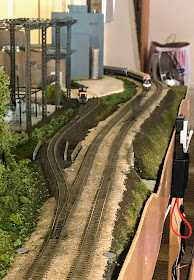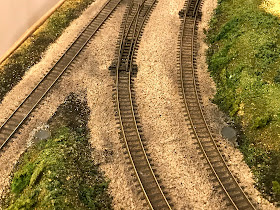 |
| My improvised painting rig made good use of the towers' magnetic bases. I applied masking tape to a particularly magnetic steel ruler, and then taped the ruler to my Tamiya spray painting stand. I first touched up my original primer paint job, which I applied with a Rustoleum rattle can a year and half or so ago. The rattle can did not effectively reach the many nooks and crannies of the very detailed Shapeways/Designdyne towers, so I airbrushed another coat Badger Stynlrez black primer to make sure the many undercuts and complex shapes got adequate coverage. If Shapeways could use a black material for these particular items, it would be a great help as the white FUD material is quite challenging to prime. After the Stynelrez primer dried, then Vallejo Air rust, grey, and concrete colors were then applied. I used folded paper masks to ensure a sharp demarcation for the concrete footings and occasional sections of unrusted galvanized column. This is an all-rusty tower with no new galvanized column sections added, commonly found on the Washington-Philadelphia section of the 90s-present Northeast Corridor. |
 |
| This retired cookie sheet has been a staple of my magnetic mounting technique, and I used it to facilitate my painting production line. Here are all of the Old Line Corridor's catenary structures, in order of placement on the layout, ready for the next stage of painting. At this stage, the main structures and concrete footings have been painted; some of the insulators have been brush painted. Note that some towers are all 'rust', while others have new, galvanized sections added. A light gray color simulates the galvanized replacement sections. One of the four track signal towers received more gray than any of the other towers; this style of tower, for some reason, maintains more of its original gray/aluminum color and does not rust through as thoroughly as the more common non-signal K-braced towers. |
 |
| Before: roofing nails used for catenary tower bases are sufficiently magnetic and form a good grip into the sandwich of ballast, cork roadbed, and styrofoam baseboard, but they sure are shiny! |
 |
| After: to kill the shine of the roofing nail heads, I sploshed (check out my UK vocabulary, maybe the Continental Modeller subscription and Kathy Millatt videos are rubbing off) some old-fashioned Testor Flat Gray enamel on each of the heads to subdue them in preparation for ballasting and blending them in. Smell evokes powerful memories, and the whiff of solvent-based enamel transported me back to my earliest days of model making. That now-rare smell of and the modest challenge of tracking down a store that still carries a stock of Testor enamel reminded me that solvent-based paints are no longer part of the model making mainstream. |
In our next installment, Part 3: Re-installing and blending in the catenary towers on the Old Line Corridor.


















